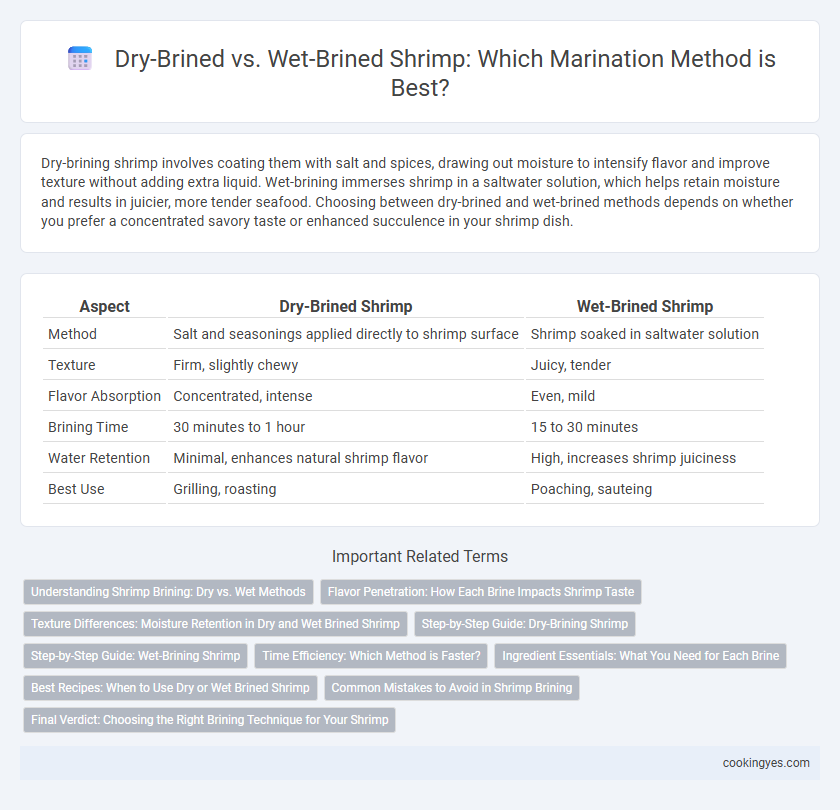Dry-brining shrimp involves coating them with salt and spices, drawing out moisture to intensify flavor and improve texture without adding extra liquid. Wet-brining immerses shrimp in a saltwater solution, which helps retain moisture and results in juicier, more tender seafood. Choosing between dry-brined and wet-brined methods depends on whether you prefer a concentrated savory taste or enhanced succulence in your shrimp dish.
Table of Comparison
| Aspect | Dry-Brined Shrimp | Wet-Brined Shrimp |
|---|---|---|
| Method | Salt and seasonings applied directly to shrimp surface | Shrimp soaked in saltwater solution |
| Texture | Firm, slightly chewy | Juicy, tender |
| Flavor Absorption | Concentrated, intense | Even, mild |
| Brining Time | 30 minutes to 1 hour | 15 to 30 minutes |
| Water Retention | Minimal, enhances natural shrimp flavor | High, increases shrimp juiciness |
| Best Use | Grilling, roasting | Poaching, sauteing |
Understanding Shrimp Brining: Dry vs. Wet Methods
Dry-brining shrimp involves coating the seafood with salt and allowing it to rest, which enhances natural flavors and improves texture by drawing out excess moisture. Wet-brining submerges shrimp in a saltwater solution, promoting moisture retention and a juicier result while often incorporating additional seasonings for flavor infusion. Choosing between dry and wet brining depends on the desired texture and flavor intensity, with dry brining offering a firmer bite and wet brining yielding plumper, more tender shrimp.
Flavor Penetration: How Each Brine Impacts Shrimp Taste
Dry-brining shrimp enhances flavor penetration by drawing out surface moisture, allowing salt and seasonings to concentrate directly into the flesh, resulting in a more intense and savory taste. Wet-brining, involving a saltwater solution, promotes uniform seasoning and moisture retention, yielding a juicier, subtly seasoned shrimp with balanced flavor infusion. The choice between dry and wet brine influences shrimp texture and taste depth, with dry brining intensifying flavors and wet brining preserving natural juiciness while providing moderate seasoning.
Texture Differences: Moisture Retention in Dry and Wet Brined Shrimp
Dry-brined shrimp absorb salt directly into the muscle fibers, resulting in a firmer texture with enhanced moisture retention that prevents toughness during cooking. Wet-brined shrimp soak in a saltwater solution, which increases moisture content and creates a plumper, juicier texture but may lead to slight waterlogging if over-brined. Understanding these differences helps optimize shrimp texture by balancing salt penetration and moisture maintenance for desired culinary outcomes.
Step-by-Step Guide: Dry-Brining Shrimp
Dry-brining shrimp involves coating them evenly with salt and optional spices, then refrigerating for 15 to 30 minutes to enhance flavor and texture by removing excess moisture. This method intensifies the shrimp's natural taste and improves firmness without diluting flavors, unlike wet-brining which uses a saltwater solution. To dry-brine, pat shrimp dry, sprinkle with kosher salt and desired seasonings, place in a single layer on a tray, and refrigerate uncovered before cooking.
Step-by-Step Guide: Wet-Brining Shrimp
Wet-brining shrimp involves submerging them in a seasoned saltwater solution, typically made with water, kosher salt, and optional sugar or spices, for 15 to 30 minutes to enhance moisture retention and flavor. Start by dissolving salt evenly in cold water, then add peeled and deveined shrimp, ensuring full coverage, and refrigerate during the brining process to maintain freshness. After brining, rinse shrimp briefly under cold water to remove excess salt, pat dry thoroughly, and proceed with cooking to achieve a tender and juicy texture.
Time Efficiency: Which Method is Faster?
Dry-brining shrimp is generally faster, requiring only 15-30 minutes to draw out moisture and enhance flavor compared to wet-brining, which can take 30 minutes to an hour for optimal absorption. The absence of excess water in dry-brining reduces prep time and ensures a more concentrated seasoning on the shrimp. This time efficiency makes dry-brining a preferred method for quick and flavorful shrimp marination.
Ingredient Essentials: What You Need for Each Brine
Dry-brined shrimp require kosher salt and optional spices like paprika, garlic powder, or cayenne to enhance flavor and texture by drawing moisture out. Wet-brined shrimp use a mixture of water, salt, and sugar, with additional aromatics such as bay leaves, peppercorns, and lemon slices to infuse moisture and subtle tastes. Both brines need balanced salt concentration--typically 2-3% for dry brines and a 5-8% salt solution for wet brines--for optimal shrimp hydration and seasoning.
Best Recipes: When to Use Dry or Wet Brined Shrimp
Dry-brining shrimp enhances natural flavors and firm texture by drawing out moisture with coarse salt and spices, ideal for grilling or sauteing recipes. Wet brining involves soaking shrimp in a seasoned saltwater solution, which promotes juiciness and even seasoning, perfect for boiling or frying dishes. Choosing between dry or wet brine depends on the cooking method and desired shrimp texture in recipes like shrimp scampi (dry brine) or fried popcorn shrimp (wet brine).
Common Mistakes to Avoid in Shrimp Brining
Over-brining shrimp, whether dry or wet, can lead to an overly salty and mushy texture, compromising its natural sweetness. Using water that is not cold during wet-brining increases the risk of bacterial growth, decreasing food safety. Avoiding prolonged brining times and not rinsing the shrimp properly after brining helps maintain the ideal flavor and texture.
Final Verdict: Choosing the Right Brining Technique for Your Shrimp
Dry-brining shrimp involves coating them with salt and allowing them to rest, which intensifies flavor and improves texture by drawing out moisture and then reabsorbing it, resulting in a firmer bite. Wet-brining, where shrimp soak in a saltwater solution, provides juiciness and subtle seasoning, making it ideal for recipes that require moist, succulent shrimp. Choosing the right brining technique depends on desired texture: select dry-brining for a concentrated flavor and firmer texture, or wet-brining for enhanced moisture and tenderness.
Dry-brined vs wet-brined for shrimp marination Infographic

 cookingyes.com
cookingyes.com